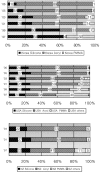Cataract and refractive surgery in ; a survey of KSCRS members from 1995~2006
- PMID: 19794938
- PMCID: PMC2739965
- DOI: 10.3341/kjo.2009.23.3.142
Cataract and refractive surgery in ; a survey of KSCRS members from 1995~2006
Abstract
Purpose: This purpose of this report was to study trends in cataract and refractive surgeries conducted during the past twelve years and to compare results to previous reports from the ASCRS and New Zealand (NZ) in order to forecast future medical services.
Methods: We surveyed members of the Korean Society of Cataract and Refractive Surgery (KSCRS) every year from 1995 to 2006, and studied changes in cataract and refractive surgeries (RS).
Results: The duration of hospitalization has been gradually decreasing to the point that a one day hospitalization following surgery has become common. The rate of topical anesthesia use has significantly increased since 1998. Sutureless incision methods are now commonly practiced. The use of acryl IOL as an optic material has been gradually increasing for cataract surgeries. KSCRS members showed an interest in the special intraocular lenses as multifocal IOL. While Excimer laser PRK was the most popular refractive surgery during the first stage, KSCRS members increasingly prefer LASIK to the Excimer laser PRK. Regression of the corrected visual acuity, dry eye, night halo, and flashes were the most common complications following refractive surgeries. Medical disputes related to PRK and LASIK have been gradually increasing throughout the study period.
Conclusions: We confirm that the KSCRS practice styles for cataract and RS are similar to those of the ASCRS and NZ. We infer a world-wide trend from the comparison of these three societies.
Keywords: Cataract surgery; KSCRS; Refractive surgery; Survey.
Figures








Similar articles
-
Practice styles and preferences of ASCRS members--1999 survey.J Cataract Refract Surg. 2000 Jun;26(6):913-21. doi: 10.1016/s0886-3350(00)00469-7. J Cataract Refract Surg. 2000. PMID: 10889439
-
Current trends in cataract and refractive surgery in Japan: 1999 survey.Jpn J Ophthalmol. 2001 Jul-Aug;45(4):383-7. doi: 10.1016/s0021-5155(01)00333-1. Jpn J Ophthalmol. 2001. PMID: 11485771
-
Current trends in cataract and refractive surgery in Japan: 1997 survey.Jpn J Ophthalmol. 1999 Mar-Apr;43(2):139-47. doi: 10.1016/s0021-5155(98)00070-7. Jpn J Ophthalmol. 1999. PMID: 10340797
-
Intra-ocular lens calculation status after corneal refractive surgery.Curr Opin Ophthalmol. 2001 Feb;12(1):17-29. doi: 10.1097/00055735-200102000-00005. Curr Opin Ophthalmol. 2001. PMID: 11150077 Review.
-
Intraocular lens calculations status after corneal refractive surgery.Curr Opin Ophthalmol. 2000 Feb;11(1):35-46. doi: 10.1097/00055735-200002000-00006. Curr Opin Ophthalmol. 2000. PMID: 10724826 Review.
Cited by
-
A Review of the Usage and Post-surgical Outcomes of Anesthesia for Laser In Situ Keratomileusis (LASIK) Procedure.Cureus. 2022 Oct 12;14(10):e30241. doi: 10.7759/cureus.30241. eCollection 2022 Oct. Cureus. 2022. PMID: 36381848 Free PMC article. Review.
-
Investigation of the Changes in Refractive Surgery Trends in Korea.Korean J Ophthalmol. 2018 Feb;32(1):8-15. doi: 10.3341/kjo.2017.0010. Epub 2018 Jan 25. Korean J Ophthalmol. 2018. PMID: 29376229 Free PMC article.
-
Excimer laser refractive surgery rate in Iran: 2010-2014.J Curr Ophthalmol. 2017 Jun 1;30(4):311-314. doi: 10.1016/j.joco.2017.05.006. eCollection 2018 Dec. J Curr Ophthalmol. 2017. PMID: 30555962 Free PMC article.
-
Transition to phacoemulsification at the farabi eye hospital, iran.Middle East Afr J Ophthalmol. 2011 Apr;18(2):173-7. doi: 10.4103/0974-9233.80709. Middle East Afr J Ophthalmol. 2011. PMID: 21731331 Free PMC article.
-
Cataract Surgery Practice in the Republic of Korea: A Survey of the Korean Society of Cataract and Refractive Surgery 2020.Korean J Ophthalmol. 2021 Aug;35(4):272-279. doi: 10.3341/kjo.2020.0001. Epub 2021 Jun 21. Korean J Ophthalmol. 2021. PMID: 34162191 Free PMC article.
References
-
- Shyn KH, Baek NH, Lee JH, et al. Current trends in cataract and refractive surgery in Korea - 1995 Survey for KSCRS Members. J Korean Ophthalmol Soc. 1998;39:892–899.
-
- Shyn KH, Shim JK, Park SW. Current trends in cataract and refractive surgery in Korea - 1996 Survey for KSCRS Members. J Korean Ophthalmol Soc. 1999;40:403–408.
-
- Shyn KH, Shin SH, Kim JS. Current trends in cataract and refractive surgery in Korea - 1997 Survey for KSCRS Members. J Korean Ophthalmol Soc. 1999;40:950–958.
-
- Shyn KH, Park SW, Kim JS. Current trends in cataract and refractive surgery in Korea - 1998 Survey for KSCRS Members. J Korean Ophthalmol Soc. 2000;41:1523–1531.
-
- Shyn KH, Oh KH, Park KS. Current trends in cataract and refractive surgery in Korea - 1999 Survey for KSCRS Members. J Korean Ophthalmol Soc. 2001;42:713–723.
MeSH terms
LinkOut - more resources
Full Text Sources
Miscellaneous

